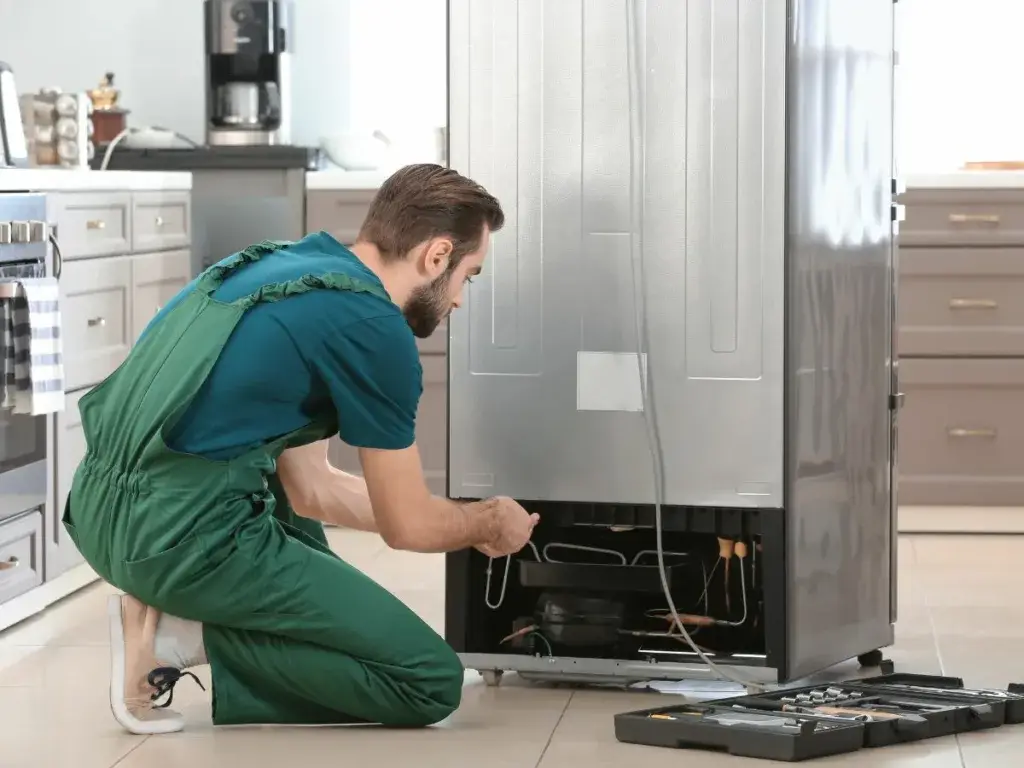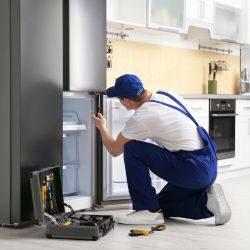
We understand that you want to protect your investment. Whirlpool fridges are great home appliances, and we are here to ensure that we get them up and running in no time. We are proud to say we offer repair services in and around the upper highway area, including Hillcrest Durban. Get a repair quote with us now
Common Causes of Fridge Freezer Leaks
Leaks can be caused by the following elements:
Clogged or Frozen Defrost Drain: Your fridge has a defrost cycle that melts frost. This water travels down the defrost drain, usually located at the back of the freezer, and into a pan below. A clog or frozen drain can cause water to back up and leak.
Damaged or Misaligned Defrost Drain Pan: This pan collects the defrosted water, which later evaporates. Cracks, wear, or misalignment can let water spill onto the floor.
Faulty Door Gasket or Seal: The gasket is the rubber seal around your fridge and freezer doors. If damaged or worn, warm air slips in, causing condensation or frost buildup, which leads to leaks when it melts.
Leaking Water Supply Line: Some fridges have an external water line for ice makers or dispensers. A leak here can drip or pool inside or behind the appliance.
Excessive Frost Build-Up: Improper airflow, frequent door opening, or things such high humidity can lead to frost accumulation. Melting frost creates excess water that your fridge may struggle to handle.
Identifying where the leaks are coming from
Observation and Inspection: Start with the basics. Where is the puddle? Check inside the fridge, under it, and also behind it. Empty the freezer (if it’s the culprit) for a more thorough look.
Testing the Defrost Drain: Find the drain hole inside your freezer. Pour a small amount of warm water down it. If water backs up or appears under the fridge, you likely have a clog.
Checking the Water Supply Line: If your model has a water line, trace it from the wall to the fridge. Look for signs of dripping or dampness on the line or connectors.
Assessing Frost Accumulation: Open the freezer and check for unusual frost amounts on stored items, back walls, or the floor. This might be your sign of excessive buildup.
Fixing these leaks
Unclogging the Defrost Drain: Find your user manual for instructions, as the access point can vary. Use warm (not hot) water and a flexible tube or turkey baster to flush the drain. A diluted vinegar solution can help break up clogs, too.
Repairing or Replacing the Defrost Drain Pan: Assess the pan for cracks or damage. Small cracks may be fixable with epoxy. Severe damage or misalignment usually means buying a new pan from the manufacturer.
Replacing the Door Gasket or Seal: Inspect the gasket for tears, worn spots, or brittleness. Replacement gaskets are specific to your model and can be ordered online or from appliance stores.
Fixing or Replacing the Water Supply Line: Leaky lines or connectors may need tightening or replacement. Basic plumbing skills can help, or a plumber can fix it if you’re unsure.
How to prevent future leaks
Regular Maintenance and Cleaning: A clean fridge works better! Clear debris from around condenser coils (usually at the back or bottom), and wipe door gaskets often to prevent food residue buildup.
Proper Temperature Settings: Consult your manual for the ideal fridge and freezer temperature. Too cold leads to frost, too warm allows condensation.
Promptly Addressing Issues: Small leaks get bigger over time. Address potential problems right away.
Conclusion
Although a leaky fridge or freezer is irritating , a little detective work and DIY know-how can often prevent expensive repairs. Understanding these common causes and solutions puts you in a better position to maintain a water-tight and efficient appliance! Get in touch with our whirlpool service agents
